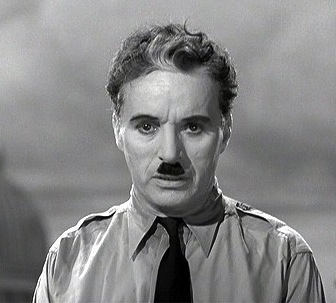Chaplin the Visionary
by Dorothea
The Power & Courage of Charlie Chaplin’s Prophetic 1940 Film
“The Great Dictator”
Today, 70 years ago, the Nazi concentration camp of Auschwitz was liberated and the first photographs emerged of the scale of the horror. In hindsight, one realizes to what extent Charlie Chaplin‘s 1940 film “The Great Dictator” was visionary and courageous. Chaplin later said that “he would not have made the film had he known about the actual horrors of the Nazi concentration camps at the time”.
This solemn day of remembrance, when the world saw the first images of Auschwitz, reminds me never to ignore the signs of oppression and often artists and intellectuals are the first who have the courage to speak out: let’s listen and act…
 The “Jewish barber” character from the film “The Great Dictator“ in a concentration camp.
The “Jewish barber” character from the film “The Great Dictator“ in a concentration camp.
Chaplin took on Hitler by making the film, and I am amazed at his use of comic ridicule to portray Hitler/Hynkel. In the film Chaplin plays both a Jewish barber and a fierce dictator, who happen to resemble each other…Chaplin, however, added to the credits of “The Great Dictator” the following warning; “Any resemblance between Hynkel the Dictator and the Jewish barber is purely coincidental.”
The importance of the film is magnificently told in the documentary “The Tramp and the Dictator”, you can see it on Youtube (click to view). It explains both the political and cinematic genius of the film. One narrator refers to Chaplin as “a Comic David who would fight Goliath”.
Chaplin started thinking about the film as early as 1937, encouraged by his friend the legendary English producer Alexander Korda. Around that time both Chaplin and French film-maker René Clair viewed Riefenstahl’s “Triumph of the Will” together at a showing at the New York Museum of Modern Art. This film was blatant Nazi propaganda, but brilliantly made, with powerful camera techniques that soon became famous.
 A “propaganda type” scene of Hynkel with a cute baby and pretty girls in folkloric dress.
A “propaganda type” scene of Hynkel with a cute baby and pretty girls in folkloric dress.
Rene Clair was horrified by the effectiveness of the film “Triumph”, crying out that this should never be shown or the West was lost. Chaplin, on the other hand, laughed uproariously at the film. It provided many elements of “The Great Dictator”, and it was repeated viewings of “Triumph of the Will” that allowed Chaplin to so closely mimic Hitler’s mannerisms. It is suspected Chaplin’s decision to go ahead with making “The Great Dictator” was finalized by his viewing of Riefenstahl’s film. The idea of the “Globe” scene came from a photograph Chaplin saw of Hitler’s office, designed by Albert Speer:
 The genius scene of “Hynkel”, the dictator, playing with the world (click to see scene)
The genius scene of “Hynkel”, the dictator, playing with the world (click to see scene)
 The Dictator is “dwarfed” by the size of his office…
The Dictator is “dwarfed” by the size of his office…
As soon as the film was announced, Chaplin met with fierce resistance both in Hollywood and politically around the world. In 1938 Hitler was regarded as a very successful leader, a force against communism and political leaders chose to ignore the blatant signs of the Nazi regime’s true nature. Chaplin not just understood those signs, he portrays them very accurately.
 The Jewish Barber trying to wipe clean his shop window.
The Jewish Barber trying to wipe clean his shop window.
Chaplin decided to auto finance the film and the set was closed so nothing would leak out before the premiere. It was Chaplin’s first “talkie”, he had maintained his silent movie career all throughout the 1930’s and said: “This is the first picture in which the story is bigger than the Little Tramp.” Under the guise of a parody, the message is very clear: Chaplin felt he needed not just his genius use of imagery and body language but for the first time his VOICE to pass on a warning, it is a deeply political and daring movie. In a notorious NAZI propaganda film “The Eternal Jew” Chaplin was falsely portrayed as Jewish but he never denied this out of solidarity.
The speech at the end of the film has become legendary, like the “I have a Dream” speech by Dr. Martin Luther King. Chaplin chose to end his film on this solemn yet hopeful note, as Hitler had already by that time invaded Poland, France, Denmark, Holland and Belgium.
 Charlie Chaplin’s delivering his speech at the end of “The Great Dictator”
Charlie Chaplin’s delivering his speech at the end of “The Great Dictator”
Although Chaplin emphatically stated that the barber was not The Tramp, he retains the Tramp’s moustache, hat, and general appearance. Despite a few silent scenes, the barber speaks throughout the film (using Chaplin’s own British accent), including the passionate plea for peace in the Final Speech (click to view) that has been widely interpreted as Chaplin speaking as himself.
